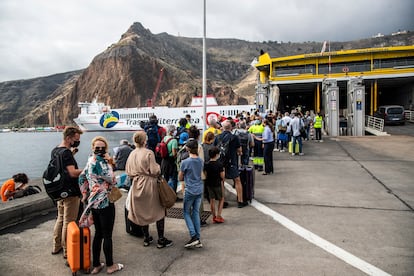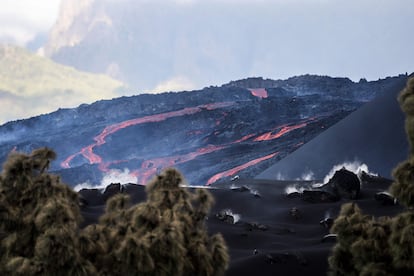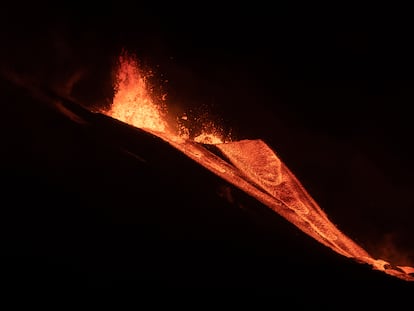La Palma airport inoperative due to volcano, leaving thousands stranded
Many passengers have been forced to travel to the nearby Canary Island of Tenerife, as winds disperse volcanic ash from the eruption


The volcano on the Canary Island of La Palma is attracting tourists every weekend. And sometimes, the ongoing eruption means that they are unable to leave – or at least that doing so is incredibly difficult. The island, located off the northwestern coast of Africa, has become a bottleneck for thousands of tourists who have packed out the hotels and roads over the last few days. The cause of the problem is wind from the west, which has dispersed the cloud of ash coming from the eruption and left the airport on the island inoperative from 1pm on Saturday.
As a result of this, the airlines that operate from La Palma had to suspend the dozen or so flights that were scheduled for Sunday. The adverse conditions are due to continue, at least, for the next 48 hours, according to the scientific spokesperson from the team of experts monitoring the phenomenon, the Volcano Risk Prevention Plan (Pevolca). The alternative is to flee on the ferry to another Canary Island, Tenerife.
“Iberia is a complete disgrace,” complained Unai, sitting on a bench at the airport, while he desperately searched for plane tickets to Bilbao in Spain’s Basque Country on his computer. He had been on the island for a week. “The counter is closed and they don’t open until 4.30pm,” he said about the Spanish airline. “It’s shameful… It’s outrageous.”
Víctor Caballero found himself in the same situation. He’s the spokesperson for the walking association, Gran Canaria A Pie (or, Gran Canaria on Foot). He arrived on Friday with a group of 25 people to walk the routes of the island and to see the volcano. Binter, he explained, the regional airline that covers the air routes between the Canary Islands, “has given us no alternative.” They told them “to work it out for ourselves.”

The alternative for those left without a flight is to take the ferry to Los Cristianos on Tenerife, and from there to travel to Tenerife Norte airport – a route that costs around €95 by taxi. At the port in Santa Cruz de La Palma the tickets had sold out at the weekend – in fact those wanting to sail with their cars on board were out of luck by midday Saturday.
“We were going to leave on Saturday, and they canceled the flight without giving us any explanations on Friday night,” explained Esther, who joined the chorus of voices criticizing Iberia. “They should have a set-up with more boats for situations like this one. If not, people won’t come…”
Volcanic sand presents a genuine danger for air travel. Firstly, it can block up the sensors that the plane uses to measure static and dynamic pressure, which are essential for measuring the altitude and speed of the aircraft. They can also erode the windows in the cockpit, making it more difficult for the pilots to see. And most serious of all, the ash is abrasive and can cause wear in engine components, such as the compressor, injectors, combustion chambers and the turbine. This wear can produce a reduction or loss of thrust. In 2010, the eruption of Eyjafjallajökull in Iceland caused the closure of the airspace across practically all of Europe, and left more than 10 million passengers stranded.
“I need to be in Madrid tomorrow,” complained Sandra Sánchez in the port terminal, while trying to keep an eye on her six-year-old son. She had been desperately seeking two air tickets. “And I’m not going to manage it,” she complained. “There are no seats.”
The ash and the gases have not just been disrupting civil aviation. The eruption, which began more than two months ago now, has been causing the quality of the air in the south of the island to deteriorate and is making it difficult for residents to enter the areas that have been evacuated, due to a higher concentration of sulfur dioxide.
I need to be in Madrid tomorrow. And I’m not going to manage it. There are no seatsTraveler Sandra Sánchez
The emission of this gas is “trending toward a permanent descent,” explained Miguel Ángel Morcuende, the technical director of Pevolca. But even so, the volcano has been emitting between 7,000 and 18,000 tons of the gas a day, levels considered to be “high” by Pevolca. The ash, meanwhile, is now affecting the east of the island mostly, making the use of FFP2 masks recommendable in a large part of La Palma.
Over the weekend, the eruptive cone of the volcano saw several new overflows, which have continued to feed the central lava flow that joined with the previously existing ones. The molten rock razed a further eight hectares of land that had not previously been affected. The total amount of territory covered by the lava now stands at 1,058 hectares. The lava delta created in the sea, meanwhile continued to grow and by this weekend had reached 53 hectares in area.
The earth tremors that have accompanied the eruption, meanwhile, have eased somewhat. On Sunday, barely two dozen were registered with most of them at depths in excess of 20 kilometers. The biggest earthquake measured 4.2 on the Richter scale, and took place on Saturday at 7.20pm at a depth of 35 kilometers.
The technical director of Pevolca warned residents against dropping their guard with regard to the earth tremors, and requested that people assist the scientists with their work by taking part in surveys to track the intensity of each event. “Even I have been surprised by this fall in intensity,” Morcuende explained.
Tu suscripción se está usando en otro dispositivo
¿Quieres añadir otro usuario a tu suscripción?
Si continúas leyendo en este dispositivo, no se podrá leer en el otro.
FlechaTu suscripción se está usando en otro dispositivo y solo puedes acceder a EL PAÍS desde un dispositivo a la vez.
Si quieres compartir tu cuenta, cambia tu suscripción a la modalidad Premium, así podrás añadir otro usuario. Cada uno accederá con su propia cuenta de email, lo que os permitirá personalizar vuestra experiencia en EL PAÍS.
¿Tienes una suscripción de empresa? Accede aquí para contratar más cuentas.
En el caso de no saber quién está usando tu cuenta, te recomendamos cambiar tu contraseña aquí.
Si decides continuar compartiendo tu cuenta, este mensaje se mostrará en tu dispositivo y en el de la otra persona que está usando tu cuenta de forma indefinida, afectando a tu experiencia de lectura. Puedes consultar aquí los términos y condiciones de la suscripción digital.
More information
Últimas noticias
Most viewed
- Reinhard Genzel, Nobel laureate in physics: ‘One-minute videos will never give you the truth’
- Pablo Escobar’s hippos: A serious environmental problem, 40 years on
- Charles Dubouloz, mountaineering star, retires at 36 with a farewell tour inspired by Walter Bonatti
- Why we lost the habit of sleeping in two segments and how that changed our sense of time
- The fall of a prolific science journal exposes the billion-dollar profits of scientific publishing










































